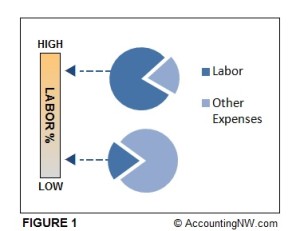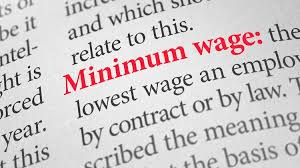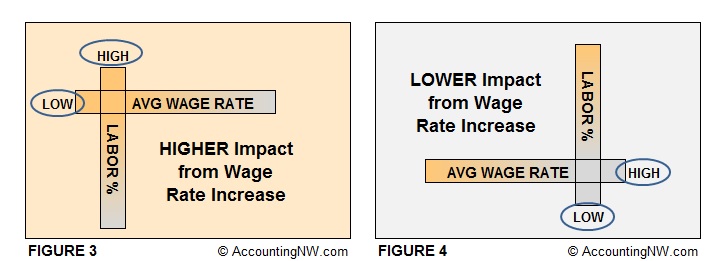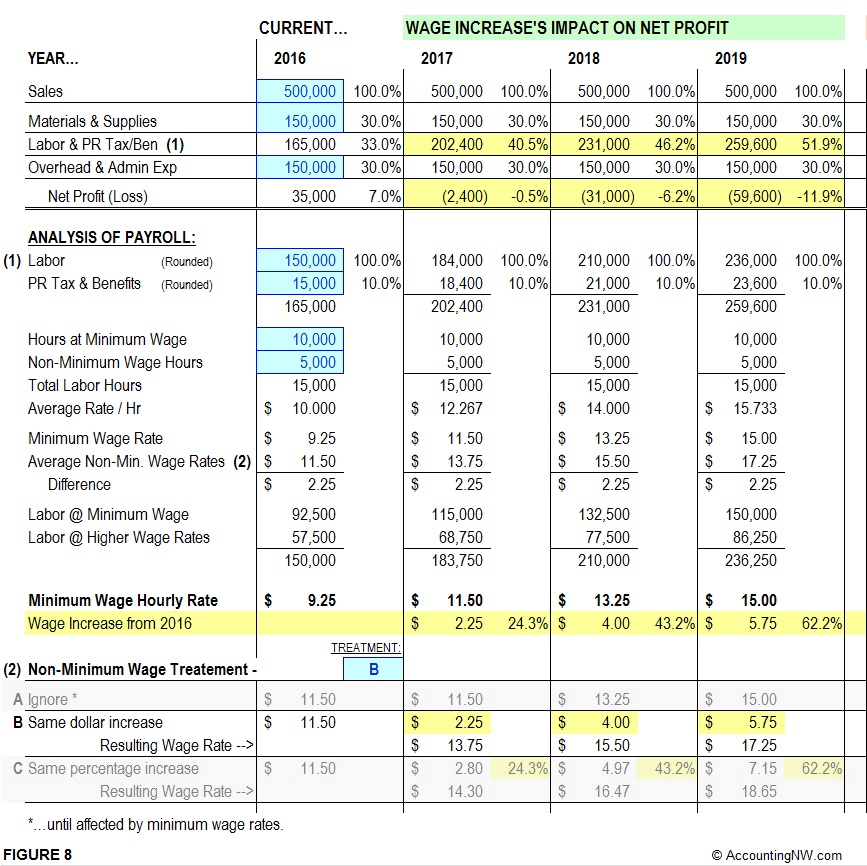Part 1 – How will the Increased Minimum Wage Rate Impact Your Business?
Part 1 –
How will the increased minimum wage rate impact your business?
Many states have, or are considering, increasing the minimum wage rate. As a business owner and/or manager, it is important that you have a clear understanding of the impact that a wage rate increase has on your operations.
This is the first in a series of posts that address an increase in minimum wage rates, the impact on your business, and some of the strategic decisions you will need to be considering to manage this change. In this post, I will review the most significant business factors that determine the extent of costs associated with a wage rate increase and also show you how to estimate the financial impact on your business.
We have developed an Excel worksheet that you can download and use to estimate the impact of a minimum wage rate increase to your business. This is a free tool (link and description listed later in the article below).
In subsequent posts, we will discuss the business strategies you will need to consider to try and off-set the wage increase. Discussions include:
- Increasing Prices
- Increasing Sales Volume
- Cutting Expenses (Including Labor)
- Other Considerations
Back to our question…
HOW WILL THE INCREASED MINIMUM WAGE RATE IMPACT YOUR BUSINESS?
Spoiler Alert! Let me give you the results first. This is an estimated financial impact on an example small business. In this example, the financial impact of a wage rate increase reduces the business’ net profits by $198,000 over a 3-year period:
There are many variables. Also many assumptions. The following discussion goes into some computation details and explanations. It may seem overwhelming, but don’t let that stop you from estimating the financial impact of a wage increase to your business.
Make sure that you the following article. Understanding the assumptions and strategic options in these articles series will help make the Excel spreadsheet a more effective tool.
Now, returning to our question… “How WILL the increased minimum wage rate impact your business?” The impact will vary greatly from business to business, but there are two significant factors that will determine the impact on any specific business: 1) the level of labor costs in relationship to your business’ total expense, and 2) the average wage rate of your labor force.
Note: In the illustrations below, the “orange” shaded areas represent a level where the wage rate increase will have a greater financial impact on your organization.
1 – Level of Labor Costs (“Labor %”):
 The first consideration is the level of labor costs (“Labor %”). The greater the level of labor costs in your organization as compared to the total costs, then the greater the financial impact a wage rate increase will have.
The first consideration is the level of labor costs (“Labor %”). The greater the level of labor costs in your organization as compared to the total costs, then the greater the financial impact a wage rate increase will have.
Simply stated, the more you business operations depend on labor, then the greater the impact of the wage rate increase.
While this may be an obvious statement, it is important to articulate it and be able to quantify it (I am an accountant after all).
2 – Average Wage Rate:
 The second consideration is the level of your average hourly wage rate. If your average rate is low, then an increase to the minimum hourly wage rate will have a greater financial impact on your business operations.
The second consideration is the level of your average hourly wage rate. If your average rate is low, then an increase to the minimum hourly wage rate will have a greater financial impact on your business operations.
A lower average wage rate exists in businesses with an entry level labor force. These jobs do not require much in preexisting skills or experience.
A key factor in these businesses is the impact of a minimum wage rate increase on the non-minimum wage rate employees. When entry level employees (starting at minimum wage) obtain skills and experience, their rates will increase over time, but not significantly. It is the nature of these positions. When there is a minimum wage rate increase, management has to determine how to handle the employees that are not impacted by the increase, but the gap between their pay rate and the minimum wage rate has closed. Does management give them a pay increase as well?
For our examples, we will be using Oregon’s proposed legislation. The State of Oregon is considering an annual rate increase in its minimum wage rate from $9.25 in 2016, to $11.50 in 2017, to $13.25 in 2018 and finally $15.00 in 2019.
Example: Billy started work at a minimum wage of $9.25/hour. After working hard, Billy received a couple of wage increases and is now earning $11.75/hour. The value of the $2.50/hour difference in Billy’s wage rate from a new employee is clearly seen by co-workers in his knowledge of the business, his customer service, and his work efficiency. Billy’s rate is over the proposed 2017 minimum wage rate of $11.50/hour, so management wouldn’t be “required” to adjust his pay rate, however, management somehow has to address the issue that only $0.25/hour difference between Billy’s pay rate and a brand new employee doesn’t reflect the value of Billy as an employee.
Because of this, businesses with a lower average pay rate will have to address the pay rates of a greater number of their employees (this situation is illustrated in the example computations further below).
High Labor % and Low Average Wage Rate:
The greatest financial impact from a wage rate increase occurs when you have a HIGH level of labor costs in relationship to your your business’ total expense, and a LOW average hourly pay rate for your labor force. Using the sliding bars in the Figures 1 and 2 above, we can combine these bars to illustrate this combined relationship:
ESTIMATING THE DOLLAR IMPACT –
I’ve estimated the dollar impact of a wage rate increase using the Excel spreadsheet we’re making available to you. We have minimized the number of variables (light-blue highlights in examples), making it easier to use. The estimate assumes that the only thing that changes over the period (years 2016 through 2019) is the labor wage rates. Remember, we are not generating a financial projection for this period. We are estimating the financial impact of this one financial variable.
With this base year information, the payroll variables must be further broken down into the Minimum Wage component and the Non-Minimum Wage component (this is automatically calculated in the Excel spreadsheet, and is illustrated/discussed on that page).
Using this information, we have the data necessary to begin assessing the impact. The only other factor needed is a management decision on how you will treat Non-Minimum Wage employees during this adjustment period. We know what the minimum wage rate increase will be, but what rate adjustments will you be making for your non-minimum wage employees.
This is a more significant issue for businesses with a greater number of employees that are close to the minimum wage rate.
When the minimum wage rate goes up, the gap between non-minimum wage employees’ pay rate and the minimum wage rate will have closed, along with the perceived value in their previous pay increases if their wage rates aren’t adjusted as well (review the example of Billy above).
There are many options, but I’m simplifying it to three: A) Ignore non-minimum wage employees and don’t increase their rates (until you have to), B) Increase their rates by the same DOLLAR increase that the minimum wage rate changes, and C) Increase their rates by the same PERCENTAGE increase that the minimum wage rate changes. This is illustrated as follows:
ESTIMATE’S RESULT – THE DOLLAR IMPACT OF THE WAGE RATE INCREASE:
For this example, we will choose option “B”. The estimate assumes no other change in the business and that the percentage of related payroll taxes and benefits to the total payroll expense will be the same. With these assumptions, the resulting estimate of the dollar impact of the wage rate increase is as follows:
WHAT DO YOU DO NEXT? WHAT STRATEGIES SHOULD BE CONSIDERED?
Estimating the financial impact is the first step. With this understanding, you can now start considering strategic steps to deal with the increased labor costs. In subsequent posts, we will discuss the benefit (and consequences) of increasing prices, increasing sales volume, and cutting expenses (including labor).
EXCEL SPREADSHEET –
We have provided an Excel spreadsheet to help you compute the financial impact of the wage increase to your business. Here is a link to the page with the Excel spreadsheet. [ LINK ]
PLEASE COMMENT BELOW –
How do you believe a Minimum Wage Rate Increase will impact your business? (Make comments relating to “managing” and decision options on the next post.)
Series Links…
- Part 1 – How will the Increased Minimum Wage Rate Impact Your Business?
- Part 2 – Managing a Minimum Wage Rate Increase – Increasing Prices, Sales Volume & Cutting Costs
- Part 3 – Increasing The Minimum Wage Rate: Solution or Problem?
- Part 4 – Excel Spreadsheet: Analyzing the Impact of a Minimum Wage Rate Increase




